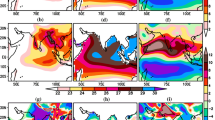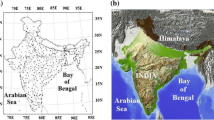Abstract
National Centers for Environmental Prediction recently upgraded its operational seasonal forecast system to the fully coupled climate modeling system referred to as CFSv2. CFSv2 has been used to make seasonal climate forecast retrospectively between 1982 and 2009 before it became operational. In this study, we evaluate the model’s ability to predict the summer temperature and precipitation over China using the 120 9-month reforecast runs initialized between January 1 and May 26 during each year of the reforecast period. These 120 reforecast runs are evaluated as an ensemble forecast using both deterministic and probabilistic metrics. The overall forecast skill for summer temperature is high while that for summer precipitation is much lower. The ensemble mean reforecasts have reduced spatial variability of the climatology. For temperature, the reforecast bias is lead time-dependent, i.e., reforecast JJA temperature become warmer when lead time is shorter. The lead time dependent bias suggests that the initial condition of temperature is somehow biased towards a warmer condition. CFSv2 is able to predict the summer temperature anomaly in China, although there is an obvious upward trend in both the observation and the reforecast. Forecasts of summer precipitation with dynamical models like CFSv2 at the seasonal time scale and a catchment scale still remain challenge, so it is necessary to improve the model physics and parameterizations for better prediction of Asian monsoon rainfall. The probabilistic skills of temperature and precipitation are quite limited. Only the spatially averaged quantities such as averaged summer temperature over the Northeast China of CFSv2 show higher forecast skill, of which is able to discriminate between event and non-event for three categorical forecasts. The potential forecast skill shows that the above and below normal events can be better forecasted than normal events. Although the shorter the forecast lead time is, the higher deterministic prediction skill appears, the probabilistic prediction skill does not increase with decreased lead time. The ensemble size does not play a significant role in affecting the overall probabilistic forecast skill although adding more members improves the probabilistic forecast skill slightly.
















Similar content being viewed by others
Explore related subjects
Discover the latest articles and news from researchers in related subjects, suggested using machine learning.Notes
At the time of this study, only reforecast runs from 1982 to 2009 are available from National Climatic Data Center.
References
Cane MA, Zebiak SE, Dolan SC (1986) Experimental forecasts of EL Nino. Nature 321(6073):827–832
Charney JG, Shukla J (1981) Predictability of monsoons. In: Lighthill J, Pearce RP (eds) Monsoon dynamics. Cambridge University Press, Cambridge, pp 99–110
Chen JY (1999) The important role of successful long-term forecast of the Yangtze River flooding in disaster prevention and migration in 1998. Science and Technology Progress and Socioeconomic Development toward the 21st Century
Chen JY (2001) The successful forecast of the torrential rain and flood over the mid-lower reaches of the Yangtze River and its scientific basis. Earth Sci Frontiers 8(1):113–121
Gao H, Yang S et al (2011) Variations of the East Asian Mei-yu and simulation and prediction by the NCEP climate forecast system. J Clim 24(1):94–108
Guo JX, Li ZC (2005) Classification of mereorological disasters and strategies for hazard prevention and reduction in China. J Catastrophol 20(4):106–110
Hamill TM (2001) Interpretation of rank histograms for verifying ensemble forecasts. Mon Weather Rev 129(3):550–560
Kanamitsu M, Ebiszaki W, Woollen J, Yang SK et al (2002) NCEP-DOE AMIP-II reanalysis (R-2). Bull Am Meteorol Soc 83(11):1631–1644
Kang IS, Jin K, Wang B, Lau KM, Shukla JA et al (2002) Intercomparison of the climatological variations of Asian summer monsoon precipitation simulated by 10 GCMs. Clim Dyn 19(5):383–395
Kim HM, Webster PJ, Curry JA (2012a) Seasonal prediction skill of ECMWF System 4 and NCEP CFSv2 retrospective forecast for the Northern Hemisphere Winter. Clim Dyn 39(12):2957–2973
Kim HM, Webster PJ, Curry JA, Toma VE (2012b) Asian summer monsoon prediction in ECMWF System 4 and NCEP CFSv2 retrospective seasonal forecasts. Clim Dyn 39(12):2975–2991
Koster RD, Suarez MJ, Liu P, Jambor U et al (2004) Realistic initialization of land surface states: impact on subseasonal forecast skill. J Hydrometeorol 5(6):1049–1063
Koster RD, Sud YC, Guo Z et al (2006) GLACE: the global land-atmosphere coupling experiment. Part I: overview. J Hydrometeorol 7(4):590–610
Kusunoki S, Sugi M, Kitoh A, Kobayashi C, Takano K (2001) Atmospheric seasonal predictability experiments by the JMA AGCM. J Meteorol Soc Jpn 79(6):1183–1206
Lang XM, Wang HJ, Jiang DB (2004) Extraseasonal short term predictions of summer climate with IAP9L-AGCM. Chin J Geophys (in Chinese) 47(1):19–24
Lau KM, Kim JH, Sud Y (1996) Intercomparison of hydrologic processes in AMIP GCMs. Bull Am Meteorol Soc 77:2209–2227
Li ZC, Guo JX, Dong LQ (1998) The Positive role of weather forecasting in combating flooding and disaster reduction during summer. Clim Environ Res (in Chinese) 3(4):335–338
Lin ZH, Li X, Zhao Y, Zhou GQ (1998) An Improved short-term climate prediction system and its application to the extraseasonal prediction of rainfall anomaly in China for 1998. Clim Environ Res (in Chinese) 3(4):339–348
Lin ZH, Zhao Y, Zhou GQ, Zeng QC (2000) Prediction of summer climate anomaly over China for 1999 and its verification. Clim Environ Res (in Chinese) 5(2):97–108
Lin ZH, Zhao Y, Zhou GQ, Zeng QC (2002) Prediction of the summer rainfall anomaly in China for 2000. Prog Nat Sci 12(7):771–774
Lin ZH, Sun JH, Wei J, Zhou GQ et al (2003) Real-time weather and seasonal climate predictions for 2001 summer and their verifications. Clim Environ Res (in Chinese) 8(3):241–257
Lin ZH, Levy JK, Xu XK, Zhao SX, Hartmann J (2005) Weather and seasona l climate prediction for flood planning in the Yangtze River Basin. Stoch Environ Res Risk Assess 19(6):428–437
Livezey RE, Masutani M, Ming JI (1996) SST-forced seasonal simulation and prediction skill for versions of the NCEP/MRF model. Bull Am Meteor Soc 77(3):507–517
Luo LF, Wood EF (2006) Assessing the idealized predictability of precipitation and temperature in the NCEP climate forecast system. Geophys Res Lett 33:L04708. doi:10.1029/2005GL025292
Luo LF, Zhang Y (2012) Did we see the 2011 summer heat wave coming? Geophys Res Lett 39:L09708. doi:10.1029/2012GL051383
Mason I (1982) A model for assessment of weather forecasts. Aust Met Mag 30:291–303
Mason SJ, Goddard L, Graham NE, Yulaeva E, Sun L, Arkin PA (1999) The IRI seasonal climate prediction system and the 1997/98 El Niño event. Bull Am Meteor Soc 80(9):1853–1874
Molteni F, Buizza R, Palmer TN, Petroliagis T (1996) The ECMWF ensemble prediction system: methodology and validation. Quart J R Meteor Soc 122(529):73–119
Orlowsky B, Bothe O, Fraedrich K et al (2010) Future climates from bias-bootstrapped weather analogs: an application to the Yangtze River Basin. J Clim 23(13):3509–3524
Palmer T, Branković Č, Richardson D (2000) A probability and decision-model analysis of PROVOST seasonal multi-model ensemble integrations. Quart J R Meteor Soc 126(567):2013–2033
Palmer T, Andersen U, Cantelaube P, Davey M et al (2004) Development of a European multi-model ensemble system for seasonal to inter-annual prediction (DEMETER). Bull Am Meteor Soc 85(6):853–872
Peng P, Barnston A, Kumar A (2013) A comparison of Skill between two versions of the NCEP climate forecast system (CFS) and CPC’s operational short-lead seasonal outlooks. Wea. Forecasting. doi:10.1175/WAF-D-12-00057.1, (in press)
Rajeevan M (2001) Prediction of Indian summer monsoon: status, problems and prospect s. Curr Sci 81:1451–1457
Saha S et al (2013) The NCEP climate forecast system version 2. J Clim (submitted to)
Saha S, Nadiga S, Thiaw C et al (2006) The NECP climate forecast system. J Clim 19(15):3483–3517
Saha S et al (2010) The NCEP climate forecast system reanalysis. Bull Am Meteor Soc 91(8):1015–1057
Seneviratne SI, Lüthi D, Litschi M, Schär C (2006) Land–atmosphere coupling and climate change in Europe. Nature 443(7108):205–209
Shukla J (2007) Monsoon mysteries. Science 318(5848):204–205
Sun J, Qu XB, Zhang JZ (2011) Analysis on the events and characters of meteorological disasters in China. Weather Forecast Rev 3(1):7–11
Talagrand O, Vautard R, Strauss B (1997) Evaluation of probabilistic prediction systems. In: Proceedings, ECMWF workshop on predictability
Wang A, Zeng X (2011) Sensitivities of terrestrial water cycle simulations to the variations of precipitation and air temperature in China. J Geophys Res 116:D02107
Wang B, Lee JY, Kang IS, Shukla J et al (2009) Advance and prospectus of seasonal prediction: assessment of the APCC/CliPAS 14-model ensemble retrospective seasonal prediction (1980–2004). Clim Dyn 33(1):93–117
Xie PP, Yatagai A, Chen M, Hayasaka T et al (2007) A gauge-based analysis of daily precipitation over East Asia. J Hydrometeorol 8(3):607–626
Xu Y, Gao XJ, Shen Y, Xu CM et al (2009) A daily temperature dataset over China and its application in validating a RCM simulation. Adv Atmos Sci 26(4):763–772
Yang S, Zhang Z, Kousky VE, Higgins RW et al (2008) Simulations and seasonal prediction of the Asian summer monsoon in the NCEP climate forecast system. J Clim 21(15):3755–3775
Yuan X, Wood EF, Luo L, Pan M (2011) A first look at climate forecast system version 2 (CFSv2) for hydrological seasonal prediction. Geophys Res Lett 38(13):L13402
Zeng QC, Yuan CG, Wang WQ, Zhang RH (1990) Extra seasonal numerical prediction on climatic anomaly. Chin J Atmos Sci (in Chinese) 14(1):10–25
Zeng QC, Yuan CH, Li X, Zhang RH, Yang FL et al (1997) Seasonal and extraseasonal predictions of summer monsoon precipitation by gems (1). Adv Atmos Sci 14(2):163–176
Zeng QC, Lin ZH, Zhou GQ (2003) Dynamical extraseasonal climate prediction system IAP DCP-II. Chin J Atmos Sci (in Chinese) 27(3):289–303
Zhang J, Wang WC, Wei J (2008) Assessing land-atmosphere coupling using soil moisture from the global land data assimilation system and observational precipitation. J Geophys Res 113:D17119
Zhang H, Lin ZH, Zeng QC (2009) The computational scheme and the test for dynamical frame work of IAP AGCM-4. Chin J Atmos Sci (in Chinese) 33(6):1267–1285
Zhang H, Lin ZH, Zeng QC (2011) The mutual response between dynamical core and physical parameterizations in atmospheric general circulation models. Clim Environ Res (in Chinese) 16(1):15–30
Acknowledgments
We would like to thank the reviewers for thoughtful and helpful comments. This research is supported by Grant NA10OAR4310246 and NA12OAR4310081 from the NOAA Climate Program Office, Grant 41175073 from National Natural Science Foundation of China and Grant U1133603 from NSFC—Yunnan Province joint Grant. CFSv2 reforecast data are provided by the National Centers for Environmental Prediction and National Climatic Data Center, observational data of precipitation and temperature are provided by the NOAA Climate Prediction Center (CPC) and the Chinese Meteorological Administration (CMA).
Author information
Authors and Affiliations
Corresponding author
Additional information
This paper is a contribution to the Topical Collection on Climate Forecast System Version 2 (CFSv2). CFSv2 is a coupled global climate model and was implemented by National Centers for Environmental Prediction (NCEP) in seasonal forecasting operations in March 2011.
Rights and permissions
About this article
Cite this article
Luo, L., Tang, W., Lin, Z. et al. Evaluation of summer temperature and precipitation predictions from NCEP CFSv2 retrospective forecast over China. Clim Dyn 41, 2213–2230 (2013). https://doi.org/10.1007/s00382-013-1927-1
Received:
Accepted:
Published:
Issue Date:
DOI: https://doi.org/10.1007/s00382-013-1927-1
Keywords
Profiles
- Lifeng Luo View author profile
- Zhaohui Lin View author profile




